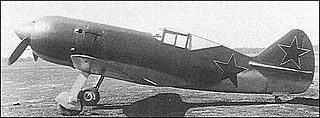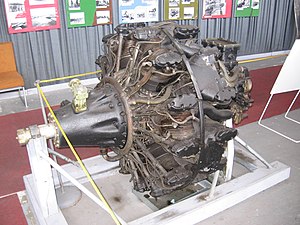
The Sukhoi Su-2 is a Soviet reconnaissance and light bomber aircraft used in the early stages of World War II. It was the first airplane designed by Pavel Sukhoi. The basic design received an engine and armament upgrade (Su-4) and was modified for the ground-attack role (ShB).

The Hispano-Suiza 12Y was an aircraft engine produced by Hispano-Suiza for the French Air Force before the Second World War. The 12Y became the primary French 1,000 hp (750 kW) class engine and was used in a number of famous aircraft, including the Morane-Saulnier M.S.406 and Dewoitine D.520.
The Lavochkin La-5 was a Soviet fighter aircraft of World War II. It was a development and refinement of the LaGG-3, replacing the earlier model's inline engine with the much more powerful Shvetsov ASh-82 radial engine. During its time in service, it was one of the Soviet Air Force's most capable types of warplane, able to fight German designs on almost equal footing.
The Tupolev Tu-70 was a Soviet passenger variant of the Tu-4 bomber, an unlicensed, reverse engineered copy of the Boeing B-29 Superfortress. Designed immediately after the end of World War II, it used a number of components from Boeing B-29s that had made emergency landings in the Soviet Union after bombing Japan. It had the first pressurized fuselage in the Soviet Union and first flew on 27 November 1946. The aircraft was successfully tested, recommended for serial production, but ultimately not produced because of more pressing military orders and because Aeroflot had no requirement for such an aircraft. A military cargo aircraft version was the Tupolev Tu-75.

The Tupolev Tu-2 is a twin-engined Soviet high-speed daylight and frontline bomber aircraft used during World War II. The Tu-2 was tailored to meet a requirement for a high-speed bomber or dive-bomber, with a large internal bomb load and speed similar to that of a single-seat fighter. Designed to challenge the German Junkers Ju 88, the Tu-2 proved comparable and was produced in torpedo, interceptor and reconnaissance versions. The Tu-2 was an effective combat aircraft and it played a key role in the final offensives of the Red Army.

The Lavochkin La-9 was a Soviet fighter aircraft produced shortly after World War II. It was one of the last piston engined fighters to be produced before the widespread adoption of the jet engine.
The Lavochkin La-126 was a World War II Soviet prototype piston-engined fighter aircraft.

The Klimov M-105 was a V12 liquid-cooled piston aircraft engine used by Soviet aircraft during World War II.

The Mikulin AM-34 (M-34) was a Soviet mass-produced, liquid-cooled, aircraft engine of domestic design. Its initial development was troubled, but it eventually became one of the most successful Soviet aircraft engines of the 1930s. It was utilized on numerous aircraft, including the Beriev MBR-2, Tupolev TB-3, Tupolev TB-4, Tupolev ANT-20, Petlyakov Pe-8, Kalinin K-7, Polikarpov I-17, and Bolkhovitinov DB-A, as well as the G-5 class and various prototype motor torpedo boats. A version of the maritime model was adapted for use in several prototype heavy tanks in 1939, although none was placed into production.

The Lavochkin-Gorbunov-Gudkov LaGG-3 was a Soviet fighter aircraft of World War II. It was a refinement of the earlier LaGG-1 and was one of the most modern aircraft available to the Soviet Air Force at the time of Germany's invasion in 1941. Compared to its opponents the LaGG-3 was underpowered and, despite its wooden construction, overweight. It was unpopular with Soviet pilots, but despite this, at one point in the war, on average 12 LaGG-3s were being completed daily and 6,528 had been built in total when production switched to the Yak-3 in 1944. The LaGG-3 was steadily improved, forming the basis for the more successful La-5 and La-7.

The Sukhoi Su-6 was a Soviet ground-attack aircraft developed during World War II. The mixed-power high-altitude interceptor Su-7 was based on the single-seat Su-6 prototype.

The Sukhoi Su-12 was a prototype Soviet reconnaissance and artillery spotter aircraft developed during World War II.

The Shvetsov ASh-62 is a nine-cylinder, air-cooled, radial aircraft engine produced in the Soviet Union. A version of this engine is produced in Poland as the ASz-62 and the People's Republic of China as the HS-5.

The Klimov M-103 is a V12 liquid-cooled piston aircraft engine used by Soviet aircraft during World War II.

The Shvetsov ASh-21 is a seven-cylinder single-row air-cooled radial aero engine.
The Shvetsov ASh-73 was an 18-cylinder, air-cooled, radial aircraft engine produced between 1947 and 1957 in the Soviet Union. It was primarily used as the powerplant for the Tupolev Tu-4 heavy bomber, an unlicensed, reverse engineered copy of the American Boeing B-29 Superfortress.

The Mikoyan-Gurevich I-211 was a prototype high-altitude Soviet fighter aircraft built during World War II. It was a version of the Mikoyan-Gurevich I-210, itself a variant of the Mikoyan-Gurevich MiG-3, fitted with a Shvetsov ASh-82F radial engine. Its development was quite prolonged, although successful, but by the time it finished its manufacturer's trials in early 1944 there was no need for a high-altitude fighter and it was not worth reducing the production of existing fighters to convert a factory over to the I-211.
UEC-Aviadvigatel JSC is a Russian developer and builder of aircraft engines, most notably jet engines for commercial aircraft. Based at the Perm Engine Plant, its products power the Ilyushin Il-76MF, Ilyushin Il-96, Tupolev Tu-204, and Tupolev Tu-214. It also designs and builds high-efficiency gas turbine units for electric power stations and for gas pumping plants. The company has its background in the Experimental Design Bureau-19 plant, set up to manufacture aircraft engines.

The Charomskiy ACh-30 was a Soviet aircraft diesel engine developed during World War II. The initial version was not very satisfactory and it was cancelled when its factory was forced to evacuate in the autumn of 1941. Production was reinitiated in the summer of 1942 and continued until September 1945 to meet the need for an economical engine to power the Soviet long-range bombers like the Petlyakov Pe-8 and the Yermolayev Yer-2.
The Shvetsov M-71 was a Soviet radial engine built in small numbers during World War II. It was derived from the Shvetsov M-25, which was a license-built copy of the American Wright R-1820-F3 Cyclone engine.
















